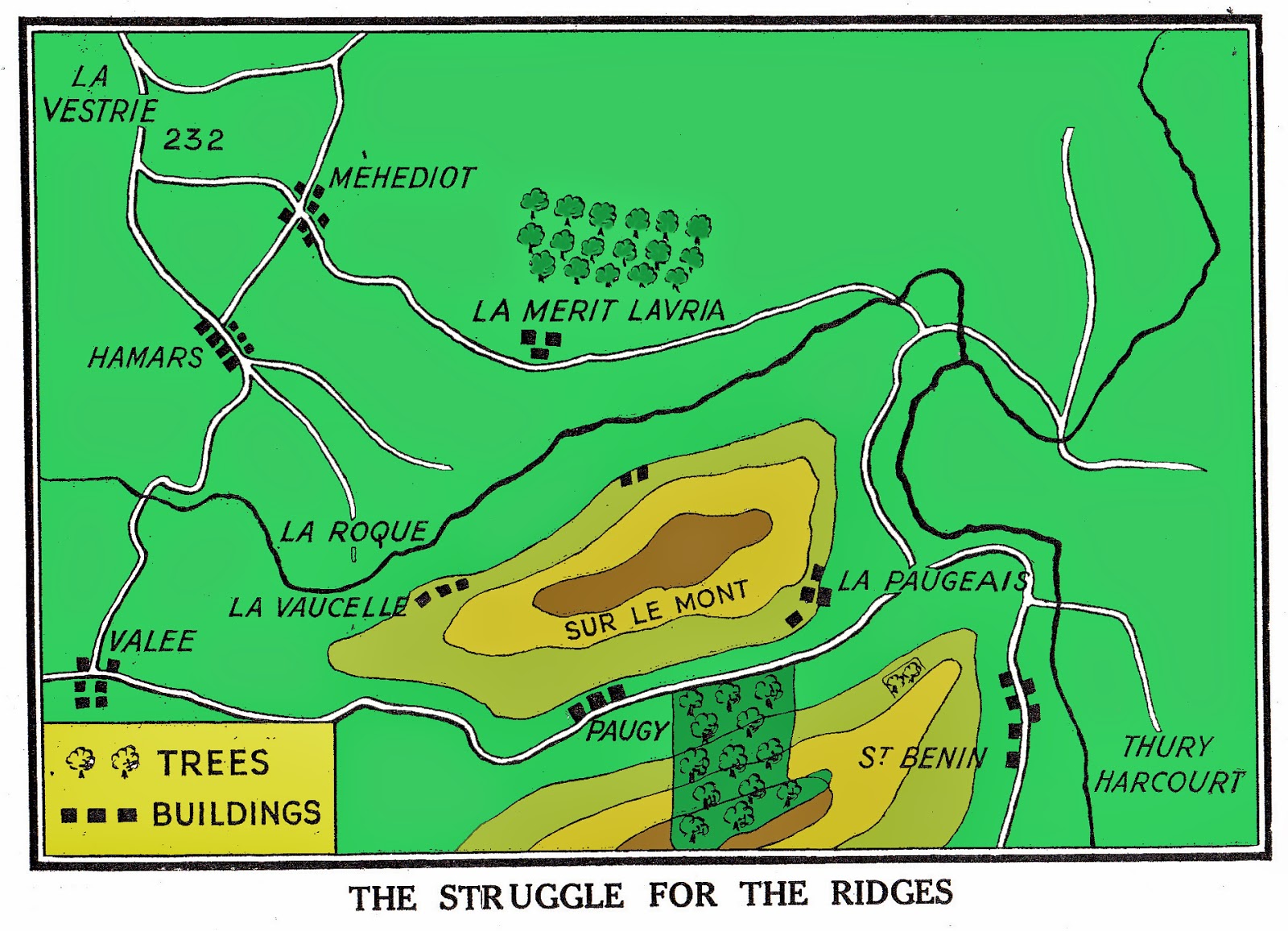Whilst their comrades in the 7th Battalion were
being hard pressed in the Grimbosq bridgehead the other South Staffordshire
battalions of 177 Brigade did not remain static. Between the Brigade and the
river lay a series of ridges of increasing height before the land dropped away
into the Orne valley. Each of these ridges overlooked its lower predecessor.
The ‘Your Men In Battle’ account describes the forward
movement of 1/6th Battalion on the 5th August after a
short period located in St Agneau le Malherbe, with the men of ‘C’ Company
(which formed the advance guard) moving up towards the river on a fleet of
bicycles shielded by a screen of carriers. The task of ‘C’ Company was to take
the high ground of La Vestrie and Point 232 located approximately to the south east
of their position in the direction of the Orne. Although these heights were
unoccupied by the Germans, such was the nature of the undulating terrain that
were the enemy to be in control of the ridge opposite La Vestrie and Point 232
every movement made by the Battalion would be observed which would spell
disaster.

Facing 1/6th ‘C’ Company was a feature called Sur
le Mont, the first of major the ridges. Additionally, another ridge of high
ground lay between Point 232 and Sur le Mont with the features of La Rocque and
La Merit Lavria to the right and left respectively. These latter two objectives
would have to be secured quickly.
‘B’ Company were tasked to take the objective of La Rocque whilst
it was the job of ‘D’ Company to capture La Merit Lavria. Critically, no tank
support was available for the attacks which were to go in at 1400 hours.
The ‘B’ Company assault was pressed home successfully and
although they were shelled, few casualties resulted. ‘D’ Company had a harder
time of it and the fact that most of their advance was made under the eyes of
the Germans meant that the defensive mortar fire was deadly accurate. Upon
approaching the objective of La Merit Lavria the Company separated, with two
platoons moving to the right and the other platoon along with Battalion H.Q.
moving to the left. The fighting was heavy and news coming back out of the line
was sparse, other than messages received to say that the men were under heavy
long range machine gun fire. ‘A’ Company under the command of Major Geoffrey
Ball were requested to come to the assistance of ‘D’ Company but they were
unable to do so, reporting back that they were ‘too tied up’. Artillery and
tank support was called upon.
At 1700 hours a message came through from ‘D’ Company’s
commander to state that one company and Battalion H.Q. had reached the
objective and that the other two platoons were attempting to link up with H.Q. ‘A’
Company were ordered to attack the position at 2100 hours. At the point where the
two parties of ‘D’ Company met up a shell exploded wounding two officers.
Consequently, the command of ‘D’ Company was taken up by C.S.M. Balding.
The 9 pm assault by ‘A’ Company was successful and all units
were able to dig in, assisted in doing so by the failing daylight. The
Battalion was now holding ground facing, but under, Sur le Mont. The Germans
knew the Battalion position and laid down heavy fire. In response, British guns
returned fire threefold.
The next challenge for the Battalion was to take Sur le Mont
itself. If successful this would leave one further ridge remaining before 177
Brigade would control the last high ground over the River Orne. To achieve this
objective, ‘A’ Company were to attack a hamlet called Sous le Mont to the left
whilst ‘B’ Company were to take the settlement of La Vaucelle on the right.
Both companies were successful in achieving their objectives and the German
units were in retreat. At this point, a patrol lead by one Lance Corporal Walker
captured ten Germans, one of whom cooperated and directed the British Artillery
guns on to the remaining German positions and this action was enough to
persuade the enemy to withdraw. Thus the objective of Sous le Mont was
delivered into Allied hands for a minimum of casualties.
In order to consolidate the Battalion gains, ‘C’ Company
under the command of Lieutenant Ellison lead an assault, with tank support, on
a position over the ridge called La Paugeais. The attack was successful and
brought the 1/6th to within one mile of the river bank. In the wake
of the attack, the Germans retreated further towards the St Benin ridge in full
sight of the British thus making themselves an easy target.
Sur le Mont was taken. The Battalion now controlled the east
to west orientated road that ran over the Orne, through Thury Harcourt across
to Falaise. However, the prize of the final ridge over the river, St Benin, was
still occupied by both British and German troops.


No comments:
Post a Comment